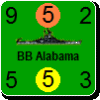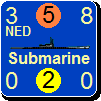rkr1958
Posts: 23483
Joined: 5/21/2009
Status: offline

|
May/Jun 1940. Allied #1 / Axis #2 Impulse Pair.
Initiative.
1. The Germans really want to move first for two major reasons. The first is that the weather is likely to be fine for most of this turn and they want to maximize the number of impulse they have to take it to France. Secondly, they fear if the allies get the initiative then the French and British could use ground strikes to break up and disrupt German units before the Germans can start their offensive.
2. First roll. The axis roll a 5, modified by 1, to a 6. The allies roll an 8. Of course, the axis choose to re-roll.
3. Second roll. The axis roll a 6, unmodified. The allies roll a 10. Not surprisingly, the allies elect to move first. The Fuhrer is furious at the German die roller. Two chances to win the initiative and he missed both. The Fuhrer in a fit of rage orders his staff to figure out what the odds were. Given that the allies win ties, the odds that Germany would win the first roll given that they had a +1 modifier was 55%. After losing the first roll, the odds that the would win the second roll lowered to 45%. Because of the +1 modifier, if the axis had won the first roll, the allies could NOT have elected to re-rolled. So, Germany would have gone first if the axis had won either roll. The chance of losing both rolls was slightly less than 25%. So, the axis (and Germany) had a 3 out of 4 chance of moving first. They missed that, the initiative went to the allies and the Fuhrer went on a rant. In his days as a runner in the trenches of WWI, he never once missed a die roll. O.K., no more die roll parodies. 
Allied #4.
4. Weather is fine across the globe except for a band of rain around the equator and in the North Monsoon weather zone.
5. CW takes a naval, France a land, China a land, USSR (neutral) combined and the USA (neutral) combined.
6. The RAF and French air forces use all their air missions to ground strike three stacks of German units. A French heavy artillery division strikes a fourth stack. Luftwaffe fighters are scrambled and oppose the three bomber ground strike missions.
7. The first target is a German stack in Antwerp that contains von Leeb's HQ unit, a 5-5 motorized corps and a 2-6 mech division. In air to air combat, Luftwaffe fighters out numbered RAF fighter units 2:1. However, neither side shots down or aborts any enemy air unit. In the first air to air combat round, the lone RAF TAC bomber unit is clear through. However, his ground strike is less than stellar. Only the 2-6 mech division is disorganized.
8. The second RAF ground strike is against a German stack in Brussels that contains Rundstedt's HQ unit, 7-4 infantry corps, 1-4 engineering division and 2 German TACs. This strike is carried out by 2 RAF bomber units escorted by an RAF fighter unit. Two Luftwaffe fighter units oppose the strike. One of the two RAF bomber units is shot down and the pilot is killed. The second RAF bomber unit makes it through to attack the target. German AA fire reduces the bomber effectiveness by 2 and the ground strike had no effect.
9. Thus ends the RAF portion of the ground strikes which only managed to disorganize a single, 2-6 mech division out of 8 units struck. Now for the French.
10. Two French fighter bomber units and one sea plane unit escorted by a French fighter unit attack a stack of German units in Belgium that contain a 9-4 infantry corps, 7-5 armor corps and a 4-2 artillery division. This strike is again opposed by two Luftwaffe fighter units. The air to air portion of the combat sees one French fighter bomber and the sea plane air unit shot down. The Luftwaffe lose a Bf-109 fighter unit. The end result was that one lone French fighter bomber unit was clear through. However, Germany AA fire reduce the effectiveness of this strike to zero. So no units were disorganized.
11. The last of the four ground strikes was a French artillery attack on a stack that contained a German 8-5 armor corps and a 3-3 artillery division. The artillery fire was ineffective and no units were disorganized.
12. This covers the significant action of the first allied impulse.
13. And taking a deep sign of relief, the Germans feel that they dodge a bullet and hope to being their offensive that will inflict mortal damage on the French army this turn.
Axis #2.
14. The Germans take a land, the Italians a naval and the Japanese a land. The Germans play an O-Chit with Rundstedt to double the factors of 8 units in land combat. Before getting to the German land combats, I need to mention the Italians and Japanese.
15. The Italians, in preparation of an invasion of Greece, move a German 6-4 corps, 6-3 corps and 1-3 SS division out to sea from the port of Trieste to the Italian coast. Both the Germans and Italians are ready to invade Greece next impulse, whether permitting. Note that the German force at sea is not an amphibious invasion force (only the 1-3 division could invade), but will embark in Albania to join the Italians in their land campaign against Greece.
16. The Japanese make one land combat in China (covered in the next post).

 Attachment (1) Attachment (1)
< Message edited by rkr1958 -- 4/14/2015 4:30:41 AM >
_____________________________
Ronnie
|
 Printable Version
Printable Version





































 New Messages
New Messages No New Messages
No New Messages Hot Topic w/ New Messages
Hot Topic w/ New Messages Hot Topic w/o New Messages
Hot Topic w/o New Messages Locked w/ New Messages
Locked w/ New Messages Locked w/o New Messages
Locked w/o New Messages Post New Thread
Post New Thread